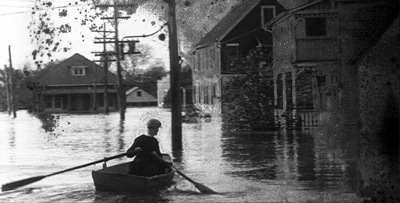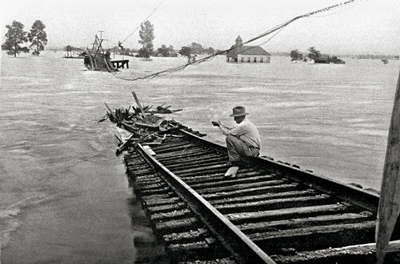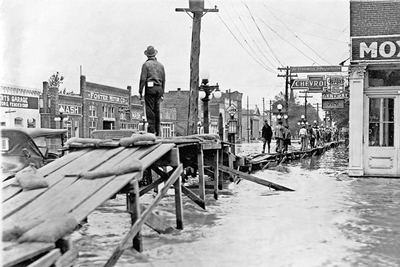Reviewed by Glenn Erickson
The Great Flood, or "My Own Private Katrina."
Experimental Collage filmmaker Bill Morrison specializes in poetic assemblages of old film footage, often without voiceover or comment. Several of his films were commissioned to accompany music by noted composers. His well received The Miner's Hymns (2011) juxtaposes aerial shots of the modern East England countryside with historical footage of the mines that were worked there, and now-forgotten labor actions of the 20th century. The images share equal emphasis with a music score by the Icelandic composer Jóhann Jóhannsson. Morrison's best known film Decasia: The State of Decay is even more abstract: the director scanned miles of vintage film that had succumbed partially or completely to nitrate decomposition. The random nature of the footage breaks down narrative conventions, as bits of old dramas, comedies and nonfiction films pass by without our knowing anything about their original context. And the weird way that the nitrate decay corrupts and twists the film images seems a comment on mortality -- images die, just like people do.
Bill Morrison's newest is The Great Flood, another meditative art film. At first glance it might seem to be a documentary about a massive 1927 flooding of the Mississippi that had widespread consequences for the Deep South. Morrison located a wealth of unedited film on the natural disaster that was apparently locked away and forgotten. Much of it had partially deteriorated, a la his earlier Decasia experiment. Morrison used this unseen film reportage to fashion not a documentary, but a free-form visual exploration.

Viewers seeing The Great Flood cold will not learn much about the actual historical event. The synopsis paragraph on the video case divulges much more information on the disaster than does the movie itself. All we're given are few chapter titles, and an opening statement saying that the Mississippi flooded and broke through its levees at 145 separate places. We must look elsewhere to learn more. Philip Horne's liner notes fill in this gap, offering many facts about the disaster and the film footage. The floods were heaviest in Mississippi and Louisiana. They forced a mass northward migration of African-Americans. We're also told that blacks were indiscriminately rounded up and forced to build and repair levees around white neighborhoods, leaving their own houses and families unprotected. These facts make a big difference for viewers unable to shake an interest in historical events, especially when we see hundreds of blacks hauling sandbags and laboring in knee-deep water.
Morrison aimed at a completely different film experience. His film might best be described as a meditative experience. It's at least 50% a showcase for Morrison's musical collaborator, guitarist and composer Bill Frisell. The music is identifiable as progressive jazz with a country feel. Conjuring strange moods and interesting guitar sounds, the audio track is occasionally more engaging than the repetitive images on screen.
Image-wise The Great Flood is slow and straightforward, as if Bill Morrison's work process were to simply arrange the footage he'd found in a logical order. We see aerial views of stricken areas, where the river has spread out to cover towns and farmland. A herd of cattle stands on a roadway a few inches above water level. Other chapters concentrate on images of people navigating flooded streets. Yet more chapters see black laborers shoring up the dams, and working on docks and warehouse platforms. Morrison slows down much of the footage to get a better look at the content -- miles of flooded roads, bits of farms that stick out above the waterline.

Of course we're reminded that 1927 was a much less technologically advanced era. But the basic problems of the disaster haven't changed. People are moving around the flooded streets by boat, and we see no indication of major relief activity except at the levees. One chapter shows the dynamiting of some levees to supposedly relieve the pressure from others. A title tells us that it didn't work.
The film opens with a lengthy digital animation of an aerial map (from satellite photos?) surveying a couple of hundred miles of the meandering Mississippi. Samuel Clemens wasn't kidding when he wrote that the layout of the river and its sandbars was alive and constantly changing. The way the main river channel twists and turns in some locations, it resembles ink squiggles or intestines.
A couple of chapters offer brief surprises. Footage shows President Hoover and other politicians making a visit, which amounts to little more than a photo op. That certainly hasn't changed. One smiling white gentleman poses with a short, withered black woman smoking a pipe. She must have been chosen to amuse potential newsreel audiences.
Another chapter breaks with the format completely to give us a pixilated-animated zip through the 1927 Sears & Roebuck mail-order catalog. What are we to make of this? The variety of goods that can be ordered by mail is impressive, and of course the prices are amusing. All the women's dresses are straight and flat, as if nobody has a figure under their clothes. The corsets and harness-like undergarments resemble torture devices. I suppose the catalog survey pays off in the next chapter, when we see groups of reasonably well-dressed people crowded in front of the camera. Perhaps groups of locals drove down after church to see what the flood area looked like. The clothing and hats worn by the women look exactly like the merchandise from the catalog. When we see a similar group of black folk exiting a church service, they seem to have been clothed by 'Sears 'n' Sawbuck' as well.

As with many avant-garde films, The Great Flood seeks a visual experience devoid of messages. Its appeal to fans of Bill Frisell and experimental music is of equal importance. The music varies quite a bit, as when Frisell employs more rock-oriented fuzz guitar sounds. The film itself ambles to a finish, with a nicely chosen visual of some black couples dancing, perhaps at a church social. One dancing woman is feeling the music just as completely (and I'd bet more purely) as might any dance interpreter of today.
Icarus Films' DVD of The Great Flood is a good encoding of this flat 4x3 presentation. Maintaining the aspect ratio of the original B&W cinematography was probably a good choice. The stereo track on the disc is so nicely recorded that one might consider re-auditing the show without one's video monitor turned on. It becomes an uninterrupted, soothing music concert.
Philip Horne's liner notes on the enclosed insert folder contain a wealth of information on the flood. We can also study the tall stack of art foundations and funding sources that made the film possible. Bill Morrison has received many artistic honors, including a Guggenheim fellowship.
On a scale of Excellent, Good, Fair, and Poor,
The Great Flood DVD
rates:
Movie: Good
Video: Very Good
Sound: Excellent
Supplements: none
Deaf and Hearing-impaired Friendly?
YES; All text is in English, there is no spoken dialogue
Packaging: Keep case
Reviewed: May 29, 2014

Text © Copyright 2014 Glenn Erickson
See more exclusive reviews on the Savant Main Page.
The version of this review on the Savant main site has additional images, footnotes and credits information, and may be updated and annotated with reader input and graphics.
Return to Top of Page
|

